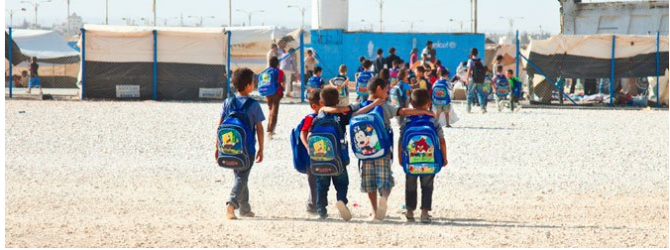-
What's Inspiring WANA - Resilience With a Smile in ...
What's Inspiring WANA - Resilience With a Smile in Za'atari Refugee Camp

As Research Fellows at the WANA Institute, we each work on individual projects that may or may not have much in common. The one common theme running throughout these projects is resilience. At the Institute, we are trying to find ways to transform resilience from an abstract concept into workable policies. But it wasn’t until the human security team paid Al-Za’atari Refugee Camp a visit in May that the concept of resilience became visible to me in an all-encompassing sense.
One of the main ways we understand resilience is not only an ability to survive, but also to thrive, in adversity. Prior to the visit, I knew that Za’atari provided all of the necessary services needed to ensure a basic quality of life. But it was the collective smiles and activities taking place under scorching sunlight that embodied a refusal to not just survive, but to live in Za’atari. Observing the extent to which people were smiling was perhaps the hardest part for me. I had presumed that the camp residents weren’t going to be cheerful. Seeing their glowing faces forced me to ask myself a difficult question - if the camp residents could smile despite all that they had been through, how is it that I can’t find it in myself to smile on a regular basis? These thoughts led me to a single conclusion: I definitely wasn’t as resilient as any of the people living there.
Al Za’atari Camp was set up three years ago in just nine days. Starting with around 100 families, the idea was that it would be a temporary arrangement until things in Syria stabilized and return was possible. It is now the largest refugee camp in the Middle East, and Jordan’s fourth largest city, hosting around 80,000 people. It has evolved from a Camp into a ‘city’ - equipped with public services such as schools, hospitals, mosques, and police stations, with none of its residents living in tents. However, what is more remarkable about Za’atari is that, despite their longing to return home, the refugees have gone out of their way to create a sense of normalcy for themselves.
Making the best out of living in Za’atari takes a lot of creativity. My favorite expression of creativity was a fully functional water fountain that served as a decoration in the center of the Camp’s most famous Shawarma store. It took me a while to realise that the fountain was in fact a showerhead that had been turned upside-down. Even more impressively, was the fact that it was an environmentally-friendly embellishment - it only turned on when there was a sufficient number of customers visiting the store. Not to be too hyperbolic, but whoever found the willpower to make that water fountain will definitely find the willpower to rebuild Syria one day.
The ability to create their own vibrant “Champs-Elysees” - which is the term used by the camp residents for the main avenue that runs through the centre of Za’atari - was a reminder of how organic and ‘natural’ commerce can be. Not exactly relatable to its namesake, Za’atari’s Champs-Elysees is lined with around 2,500 stores completely set up and run by refugees. They range from barbers, bridal shops, shisha cafes, and a pizza-delivery service. The Champs-Elysees perfectly embodies Adam Smith’s ‘invisible hand’- where an economy thrives and arranges itself organically and efficiently without state intervention. It is the only market I’ve ever been in where the phrase ‘keep the change’ did not produce its intended effect. In my basic attempt to be courteous, I suggested that the man who sold brightly-colored slushies kept the change from the 1JD I handed him. He assertively responded “Thanks ma’am, but it only costs 10 pence”.

